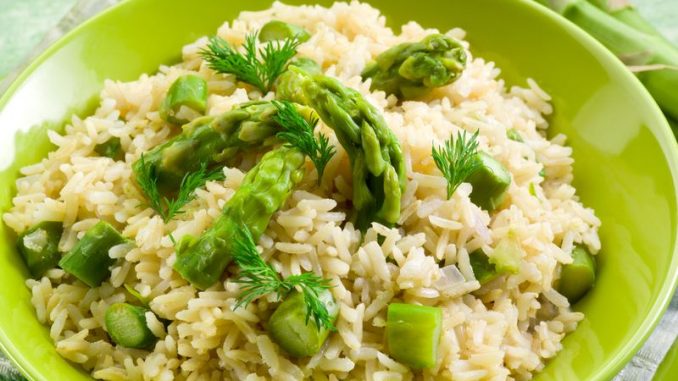
Truly the most famous of all rice dishes must be the risotto and not chow mein or pilaf although these hold great sway in their regions of origin. Italy which developed this dish produces more rice than anywhere else on the European continent. Italy also grows the most varieties and some of the best are Arborio and Carnaroli amongst others. The risotto was invested in Milan sometime in the 1500s. The best risotto are made with superfine rice and all prepared in essentially the same way. Lets face it though all sort of ingredients can be used as part of the recipe and this gives a risotto great versatility. It has also moved into the mid-week feast area of the dinner table having been the preserve of restaurants and weekend diners.
The idea is to coat the rice in oil and butter and to fry it which breaks down the rice sub-structure making it more amenable to soaking up stock. I sometimes add a glass of white wine, usually dry, right at the point when the rice has become translucent from the early frying phase. The alcohol soon disappears leaving just the essence of wine. The risotto already starts to take on a glorious aroma too.
Yes – stock ! The key word and the one which gives risotto rice its especial flavour. The stock, and it could be vegetable, chicken, fish – you name it, must really be added, one ladle at a time so that the juices soak into the rice swell up the starch contained therein. The sizzle of the frying is really the best bit of all. Another essential activity is to keep stirring the rice. A wooden spoon is a must here because it literally beats the starch out of the rice making it less ‘al dente’ and more unctious and gooey. All this stirring is over a low heat with the rice laden stock simmering gently away. The ideal method is to allow the stock to completely absorb into the rice and then add another ladle. The whole dish is cooked by degrees in about 20 minutes.
You know you have reached that glorious end when the rice is tender and creamy. The final touch is called the mantecatura. This is taking it off the heat, adding a knob of butter, a couple of spoons of olive oil and then grating fresh Parmesan over the rice. It is stirred into the risotto making it even more creamy.
Any leftover risotto can be chilled. It is often rolled into balls enclosing a piece of mozarella. This is coated in fine breadcrumbs and deep-fried or make a dish called suppli al telefono. The Sicilians prepare a version called arancini.
A classic recipe is risotto bianco or white risotto. To prepare the chicken or fish stocks, just check out the articles elsewhere as linked int the ingredient link. They are very simple to prepare and make all the difference to the dish. The risotto in our picture has been served with some boiled asparagus which makes for a delicious addition.
The stock is prepared as in other recipes and can be chicken or vegetable.
[Please note we are an affiliate marketing partner and will make a sales commission if you purchase any items through our affiliate links. Please read our affiliate disclosure]
Equipment:
- Heavy bottomed frying pan or skillet
- wooden spoon
Serving Size: 4; Preparation time: 5 minutes; Cooking time: 40-50 minutes
Ingredients:
- 1 large onion, peeled and finely chopped
- 2 wineglasses of dry white vermouth (dry Martini or Noilly Prat) or dry white wine
- 2 tablespoons olive oil
- 1 knob of butter
- 400 g risotto rice
- 2 cloves of garlic , peeled and finely chopped
- 4 or 5 sticks of celery , trimmed and finely chopped
- 1.1 litres (2 pints) stock
- 70 g butter
- 115 g freshly grated Parmesan cheese
- sea salt
- freshly ground black pepper
Preparation:
- Heat the stock if it is prepared from other sources. Stock cubes do it for me if I haven’t any other source.
- Add the olive oil and butter to a separate pan.
- Prepare a soffrito by adding onion, garlic and celery, and cook very slowly for about 15 minutes without colouring.
- When the vegetables have softened, add the rice and turn up the heat.
- Lightly fry the rice and make sure to keep stirring it. In a few minutes it will appear slightly translucent.
- Add the wine/vermouth and always keep stirring.
- Once the vermouth or wine has cooked into the rice, add your first ladle of hot stock and a good pinch of salt.
- Turn the heat down to a simmer so the rice doesn’t cook too quickly on the outside.
- Keep adding ladlefuls of stock, stirring and massaging the creamy starch out of the rice, allowing each ladleful to be absorbed before adding the next.
- This will take around 15 minutes. Taste the rice to check if it’s cooked. If not, carry on adding stock until the rice is soft but with a slight bite.
- Ensure the seasoning is followed through.
- Add boiling water if and when the stock runs out.
- Remove from the heat and add the butter and Parmesan. Stir well. Place a lid on the pan and allow to sit for 2 minutes.

Leave a Reply